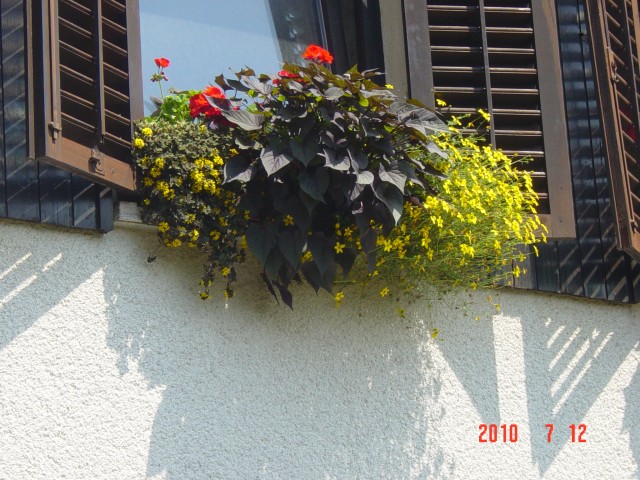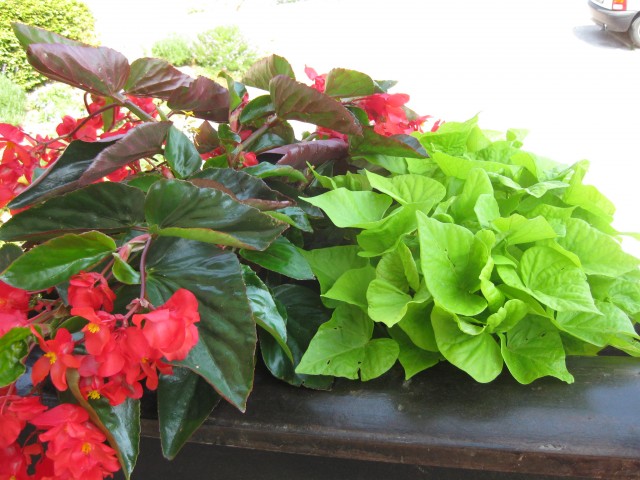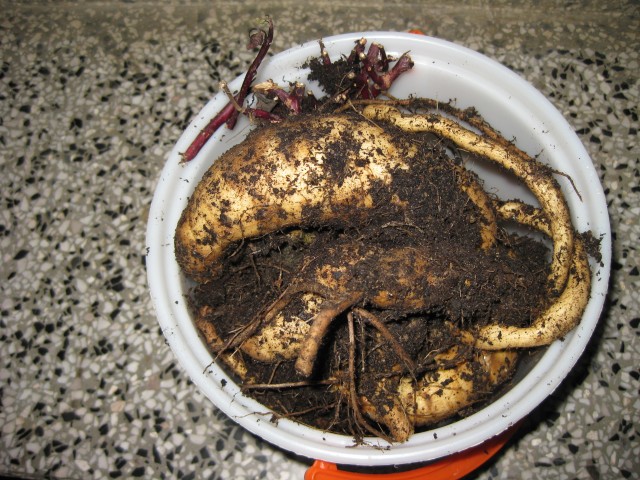Sladka batata, sladki krompir - Ipomoea batatas
-
mravlja
- Prispevkov: 4297
- Pridružen: So Maj 21, 2016 2:00 am
Pri nas je letos rastel na treh različnih lokacijah, ena med njimi je bila 25-litrska vreča kupljenega substrata, ki je "ostala" od presajanja in bila trenutni višek - kar se sicer pri nas redko zgodi.
Rezultat v vreči je bil enak, kot si ga dobila, cinija1.
Sladki krompir se nedvomno splača gojiti, dobro rodi in všeč nam je. Le "poštudirati" ga je treba. V loncu, kjer ima "mir" pred drugimi vplivi, se dobro počuti, rabi pa volumen. Po občutku se mi zdi, da bo 40cm premera (ca. 40 litrov) komaj zadosti, oz. da bi že v 60-litrskemu "dal od sebe" bistveno več. Ni pa vse v premeru, tudi višina/globina lonca šteje. Sam si ogledujem 80-litrske. Bomo še videli kaj in kako...
Rezultat v vreči je bil enak, kot si ga dobila, cinija1.
Sladki krompir se nedvomno splača gojiti, dobro rodi in všeč nam je. Le "poštudirati" ga je treba. V loncu, kjer ima "mir" pred drugimi vplivi, se dobro počuti, rabi pa volumen. Po občutku se mi zdi, da bo 40cm premera (ca. 40 litrov) komaj zadosti, oz. da bi že v 60-litrskemu "dal od sebe" bistveno več. Ni pa vse v premeru, tudi višina/globina lonca šteje. Sam si ogledujem 80-litrske. Bomo še videli kaj in kako...
- muha
- Site Admin
- Prispevkov: 18677
- Pridružen: Ne Okt 27, 2024 7:08 pm
- Kraj: Medvode okolica
Ko sem za okras imela tistega z rožnatimi gomolji in zelenimi listi, mi je v običajnem 60 cm koritu za rože naredil pošten gomolj. Zemljo je izpodrinil navzgor za 2 + cm. Škoda, da ga nisem stehtala in poslikala. V 3 koritih so bili debeli gomolji, le v enem, ob enaki vzgoji, bolj vrvičasti. A ja, še to: korita so bila na severnem balkonu in so imela poleti sonce le kake 3 ure zjutraj in 3 ure zvečer. Proti jeseni še manj. Morda nima preveč rad poletne vročine in žgočega sonca??
Pa bodi pameten!

Tale vijolični je bil na južnem oknu, vročino je dobro prestal, gomoljev ni naredil (tudi na severni legi ne):

Tale je bil na severnem balkonu, čeprav mu je kar nekaj hranil odvzela begonija, je naredil lep gomolj

Pa bodi pameten!
Tale vijolični je bil na južnem oknu, vročino je dobro prestal, gomoljev ni naredil (tudi na severni legi ne):

Tale je bil na severnem balkonu, čeprav mu je kar nekaj hranil odvzela begonija, je naredil lep gomolj

-
brbr
- Prispevkov: 8574
- Pridružen: Če Jun 06, 2013 2:00 am
Včeraj sem iz loncev pobrala rezutat mojega letošnjeg poskusa pridevale. Glede na lansko sezono, je pridelek lepopisen. Nabralo se je za 3kg gomoljev. Sem vesela.

Rastline so bile posajene v treh loncih.
V enem je rastla samo ena. Ta je naredila tudi najlešpe gomolje..

V drugem loncu sta bili dve rastlini

V tretjem pa tri.

Glede skladiščenja - v knjigi "Encikolpedija vrtnarjenja" sem prečitala, da naj bi gomolje po izkopu še najmanj en teden hranili na temperaturi 28-30st. in 85-90% vlagi. Ali kaj veste o tem?_________________naredimo svet lepši

Rastline so bile posajene v treh loncih.
V enem je rastla samo ena. Ta je naredila tudi najlešpe gomolje..

V drugem loncu sta bili dve rastlini

V tretjem pa tri.

Glede skladiščenja - v knjigi "Encikolpedija vrtnarjenja" sem prečitala, da naj bi gomolje po izkopu še najmanj en teden hranili na temperaturi 28-30st. in 85-90% vlagi. Ali kaj veste o tem?_________________naredimo svet lepši
-
Tiana
- Prispevkov: 1150
- Pridružen: To Mar 04, 2014 1:00 am
Brbr, tole sem jaz zadnjič v eni skupini na FB zasledila in tudi prvič sploh se srečala s čim takim.
Why Cure a Sweet Potato?
If you harvest a sweet potato, then bring it in and cook it, you’ll be extremely disappointed. It will have a really starchy flavor and not be sweet at all.Basically, when you cure a potato, you put the potato through a process that takes all of those starches and breaks them down into natural sugar. This is what gives a sweet potato their naturally sweet flavor. It also helps to seal in the potatoes natural moisture and activate enzymes that will repair any damage that was done during the harvest of the sweet potato.
But keep in mind, that curing needs to take place soon after harvest because if not, you could lose the potatoes as moisture will begin to get to them.
To accomplish curing in the field, we wet down a large patch of grass, place the baskets of sweet potatoes on the moist grass, and cover them all with a tarp. The sun will heat the tarp and cause the moisture left on the grass to evaporate, creating that warm, moist environment needed to cure sweet potatoes. Usually just a few days is all you need
Some people cure them in the shower or oven or whatever space they can create.
It is a process that takes anywhere from 4 to 14 days. It is where the sweet potatoes are placed in a hot environment that the temperature hangs somewhere between 80 and 85 degrees Fahrenheit.Then the area is kept at about 90% humidity. The closer you keep to these guidelines when trying to cure the sweet potatoes, the faster the sweet potatoes should cure.
After the curing process is done, then you store your sweet potatoes in an area that is kept around 55 to 60 degrees Fahrenheit for about 6 to 8 more weeks. This is so the curing process can finish.
Once this is done, then you’ll store your sweet potatoes in a root cellar, basement, closet, or anywhere else that is dark, cold, and dry.Then they’ll be ready to enjoy over the winter.
There are two main culprits to avoid once your sweet potatoes are cured. First, you need to avoid freezing cold temperatures. This will cause your sweet potatoes to turn a darker color and ruin them.
Second, you need to avoid bruising your sweet potatoes. Even cured sweet potatoes will bruise easily. Remember, when produce gets bruised, it just creates a place for rot to form. When rot forms, your harvest is in danger.
So be gentle on your sweet potatoes so they can last.
Why Cure a Sweet Potato?
If you harvest a sweet potato, then bring it in and cook it, you’ll be extremely disappointed. It will have a really starchy flavor and not be sweet at all.Basically, when you cure a potato, you put the potato through a process that takes all of those starches and breaks them down into natural sugar. This is what gives a sweet potato their naturally sweet flavor. It also helps to seal in the potatoes natural moisture and activate enzymes that will repair any damage that was done during the harvest of the sweet potato.
But keep in mind, that curing needs to take place soon after harvest because if not, you could lose the potatoes as moisture will begin to get to them.
To accomplish curing in the field, we wet down a large patch of grass, place the baskets of sweet potatoes on the moist grass, and cover them all with a tarp. The sun will heat the tarp and cause the moisture left on the grass to evaporate, creating that warm, moist environment needed to cure sweet potatoes. Usually just a few days is all you need
Some people cure them in the shower or oven or whatever space they can create.
It is a process that takes anywhere from 4 to 14 days. It is where the sweet potatoes are placed in a hot environment that the temperature hangs somewhere between 80 and 85 degrees Fahrenheit.Then the area is kept at about 90% humidity. The closer you keep to these guidelines when trying to cure the sweet potatoes, the faster the sweet potatoes should cure.
After the curing process is done, then you store your sweet potatoes in an area that is kept around 55 to 60 degrees Fahrenheit for about 6 to 8 more weeks. This is so the curing process can finish.
Once this is done, then you’ll store your sweet potatoes in a root cellar, basement, closet, or anywhere else that is dark, cold, and dry.Then they’ll be ready to enjoy over the winter.
There are two main culprits to avoid once your sweet potatoes are cured. First, you need to avoid freezing cold temperatures. This will cause your sweet potatoes to turn a darker color and ruin them.
Second, you need to avoid bruising your sweet potatoes. Even cured sweet potatoes will bruise easily. Remember, when produce gets bruised, it just creates a place for rot to form. When rot forms, your harvest is in danger.
So be gentle on your sweet potatoes so they can last.
-
brbr
- Prispevkov: 8574
- Pridružen: Če Jun 06, 2013 2:00 am
Tiana, hvala.
Ja, sem tudi jaz zasledila, da je tako ravnanje dobro, da se kožica gomoljev okrepi (se potem bolje skladiščijo in izgubljajo manj vlage), morebitne poškodbe zacelijo in, da se v gomolju razvijejo sladkorji.
Jaz sem jih shranila tako, kot svetuje "vrt obilja": v eni plasti so zloženi v plastični pladenj s pokrovom. Prekriti so z vlažno krpo, vse skupaj pa je dobro zaprto. Le toplote imajo (verjetno) premalo. So v bivalnem prostoru, kjer pa še ne kurimo. Ko bomo začeli, bom posode prestavila pod radiator. No, mogoče vse skupaj postavim v bližino štedilnika - jim bo vsaj očasno bolj toplo..._________________naredimo svet lepši
Ja, sem tudi jaz zasledila, da je tako ravnanje dobro, da se kožica gomoljev okrepi (se potem bolje skladiščijo in izgubljajo manj vlage), morebitne poškodbe zacelijo in, da se v gomolju razvijejo sladkorji.
Jaz sem jih shranila tako, kot svetuje "vrt obilja": v eni plasti so zloženi v plastični pladenj s pokrovom. Prekriti so z vlažno krpo, vse skupaj pa je dobro zaprto. Le toplote imajo (verjetno) premalo. So v bivalnem prostoru, kjer pa še ne kurimo. Ko bomo začeli, bom posode prestavila pod radiator. No, mogoče vse skupaj postavim v bližino štedilnika - jim bo vsaj očasno bolj toplo..._________________naredimo svet lepši
- muha
- Site Admin
- Prispevkov: 18677
- Pridružen: Ne Okt 27, 2024 7:08 pm
- Kraj: Medvode okolica
